An Examination of Hip Grading
The phenotypic evaluation
of hips done by the Orthopedic Foundation for Animals falls into seven
different categories. Those categories are Normal (Excellent, Good, Fair), Borderline,
and Dysplastic (Mild, Moderate, Severe). Once each of the radiologists classifies
the hip into one of the 7 phenotypes above, the final hip grade is decided
by a consensus of the 3 independent outside evaluations. Examples would
be:
- Two radiologists
reported Excellent, one Good—the final grade would be Excellent
- One radiologist
reported Excellent, one Good, one Fair—the final grade would be
Good
- One radiologist
reported Fair, two radiologists reported Mild—the final grade would
be Mild
The hip grades of Excellent, Good and Fair are within normal limits
and are given OFA numbers. This information is accepted by AKC on dogs
with permanent identification (tattoo, microchip) and is in the public
domain. Radiographs of Borderline, Mild, Moderate and Severely dysplastic
hip grades are reviewed by the OFA radiologist and a radiographic report
is generated documenting the abnormal radiographic findings. Unless the
owner has chosen the open database, dysplastic hip grades are not in the
public domain.
Excellent: this classification is assigned for superior conformation
in comparison to other animals of the same age and breed. There is a deep
seated ball (femoral head) which fits tightly into a well-formed socket
(acetabulum) with minimal joint space. There is almost complete coverage
of the socket over the ball.
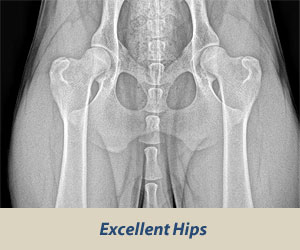
Good: slightly less than superior but a well-formed congruent
hip joint is visualized. The ball fits well into the socket and good coverage
is present.

Fair: Assigned where minor irregularities in the hip joint
exist. The hip joint is wider than a good hip phenotype. This is due to
the ball slightly slipping out of the socket causing a minor degree of
joint incongruency. There may also be slight inward deviation of the weight-bearing
surface of the socket (dorsal acetabular rim) causing the socket to appear
slightly shallow. This can be a normal finding in some breeds
however, such as the Chinese Shar Pei, Chow Chow, and Poodle.
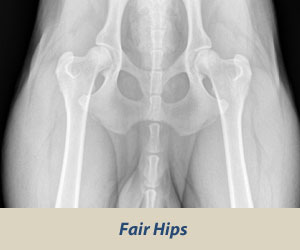
Borderline: there is no clear cut consensus between the radiologists
to place the hip into a given category of normal or dysplastic. There
is usually more incongruency present than what occurs in the minor amount
found in a fair but there are no arthritic changes present that definitively
diagnose the hip joint being dysplastic. There also may be a bony projection
present on any of the areas of the hip anatomy illustrated above that
can not accurately be assessed as being an abnormal arthritic change or
as a normal anatomic variant for that individual dog. To increase the
accuracy of a correct diagnosis, it is recommended to repeat the radiographs
at a later date (usually 6 months). This allows the radiologist to compare
the initial film with the most recent film over a given time period and
assess for progressive arthritic changes that would be expected if the
dog was truly dysplastic. Most dogs with this grade (over 50%) show no
change in hip conformation over time and receive a normal hip rating;
usually a fair hip phenotype.
Mild Hip Dysplasia: there is significant subluxation
present where the ball is partially out of the socket causing an incongruent
increased joint space. The socket is usually shallow only partially covering
the ball. There are usually no arthritic changes present with this classification
and if the dog is young (24 to 30 months of age), there is an option to
resubmit an radiograph when the dog is older so it can be reevaluated
a second time. Most dogs will remain dysplastic showing progression of
the disease with early arthritic changes. Since HD is a chronic, progressive
disease, the older the dog, the more accurate the diagnosis of HD (or
lack of HD).
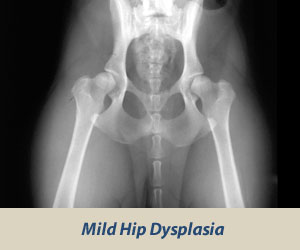
Moderate Hip Dysplasia: there is significant subluxation present
where the ball is barely seated into a shallow socket causing joint incongruency.
There are secondary arthritic bone changes usually along the femoral neck
and head (termed remodeling), acetabular rim changes (termed osteophytes
or bone spurs) and various degrees of trabecular bone pattern changes
called sclerosis. Once arthritis is reported, there is only continued
progression of arthritis over time.
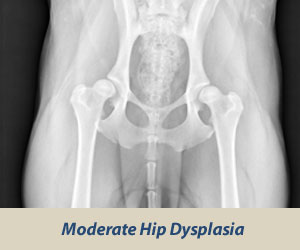
Severe Hip Dysplasia: assigned where radiographic evidence of marked
dysplasia exists. There is significant subluxation present where the ball
is partly or completely out of a shallow socket. Like moderate HD, there
are also large amounts of secondary arthritic bone changes along the femoral
neck and head, acetabular rim changes and large amounts of abnormal bone
pattern changes.
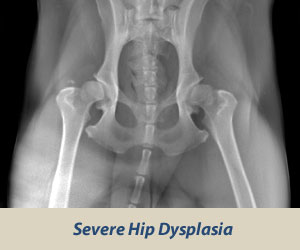
Other Hip Dysplasia Registries—An Approximation
| OFA |
FCI (European) |
BVA (UK/Australia) |
SV (Germany) |
| Excellent |
A-1 |
0-4 (no > 3/hip) |
Normal |
| Good |
A-2 |
5-10 (no > 6/hip) |
Normal |
| Fair |
B-1 |
11-18 |
Normal |
| Borderline |
B-2 |
19-25 |
Fast Normal |
| Mild |
C |
26-35 |
Noch Zugelassen |
| Moderate |
D |
36-50 |
Mittlere |
| Severe |
E |
51-106 |
Schwere |










